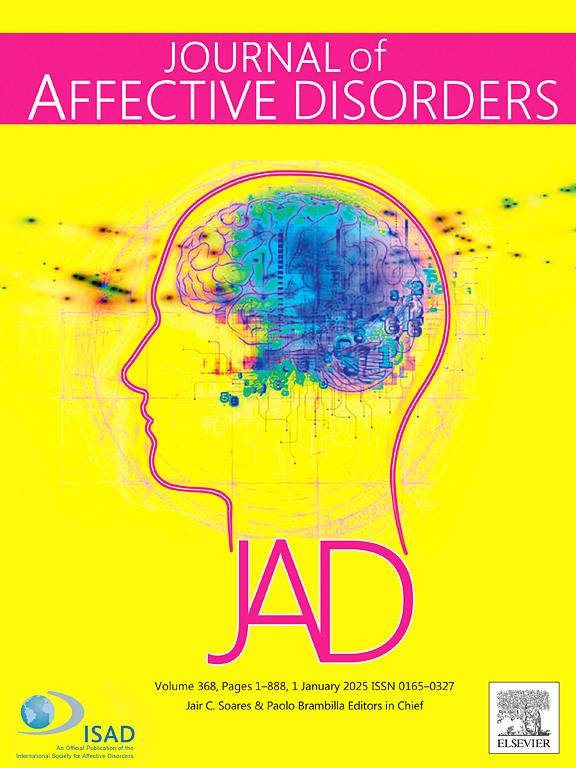An updated systematic review and meta-analysis of the predictive validity of the general anxiety disorder (GAD)-7 and GAD-2 in screening for anxiety disorders
IF 4.9
2区 医学
Q1 CLINICAL NEUROLOGY
引用次数: 0
Abstract
Background
This study was an updated systematic review and meta-analysis to examine the validity of the general anxiety disorder (GAD)-7 and GAD-2 for GAD and other anxiety disorders.
Methods
Electronic searches were performed using MEDLINE, EMBASE, CINAHL, and PsycArticles databases. This review compared the predictive validity of the GAD-7, GAD-2, and other anxiety screening tools and conducted a subgroup analysis based on the GAD-7 according to the target anxiety and participant characteristics.
Results
In total, 45 studies were selected based on the inclusion criteria. The sensitivity of GAD-7 (43 studies) was 0.81 (95 % CI, 0.78–0.84), specificity was 0.78 (95 % CI, 0.74–0.81), and sROC AUC was 0.87. For GAD-2 (13 studies), the sensitivity was 0.78 (95 % CI, 0.73–0.83), specificity was 0.81 (95 % CI, 0.73–0.86), and sROC AUC was 0.86. For other anxiety screening tools (seven studies) the sensitivity was 0.78 (95 % CI, 0.74–0.82), specificity was 0.81 (95 % CI, 0.74–0.86), sROC AUC was 0.86. In the subgroup analysis according to anxiety targets, when measuring GAD alone, the sensitivity and specificity of GAD-7 were higher than those of other anxiety disorders, with an sROC AUC of 0.88 versus 0.84. In the subgroup analysis of the participants, the sensitivity in patients with epilepsy was 0.89, which was higher than that in other participants.
Conclusions
This study demonstrated that the GAD-7 had adequate diagnostic accuracy, suggesting that it can help screen patients with anxiety disorders. Moreover, the GAD-7 has a high screening validity for anxiety in patients with epilepsy.
一项关于广泛性焦虑症(GAD)-7和GAD-2在筛查焦虑症中的预测有效性的最新系统综述和荟萃分析。
背景:本研究是一项更新的系统综述和荟萃分析,旨在检验广泛性焦虑症(GAD)-7和GAD-2对广泛性焦虑症和其他焦虑症的有效性。方法:采用MEDLINE、EMBASE、CINAHL和PsycArticles数据库进行电子检索。本综述比较了GAD-7、GAD-2和其他焦虑筛查工具的预测有效性,并根据目标焦虑和参与者特征,以GAD-7为基础进行了亚组分析。结果:根据纳入标准共纳入45项研究。GAD-7(43项研究)的敏感性为0.81(95 % CI, 0.78 ~ 0.84),特异性为0.78(95 % CI, 0.74 ~ 0.81), sROC AUC为0.87。对于GAD-2(13项研究),敏感性为0.78(95 % CI, 0.73-0.83),特异性为0.81(95 % CI, 0.73-0.86), sROC AUC为0.86。对于其他焦虑筛查工具(7项研究),敏感性为0.78(95 % CI, 0.74-0.82),特异性为0.81(95 % CI, 0.74-0.86), sROC AUC为0.86。在按焦虑指标进行的亚组分析中,单独测量GAD时,GAD-7的敏感性和特异性均高于其他焦虑症,sROC AUC分别为0.88和0.84。在参与者的亚组分析中,癫痫患者的敏感性为0.89,高于其他参与者。结论:本研究表明GAD-7具有足够的诊断准确性,提示其可以帮助筛查焦虑障碍患者。此外,GAD-7对癫痫患者的焦虑有较高的筛查效度。
本文章由计算机程序翻译,如有差异,请以英文原文为准。
求助全文
约1分钟内获得全文
求助全文
来源期刊

Journal of affective disorders
医学-精神病学
CiteScore
10.90
自引率
6.10%
发文量
1319
审稿时长
9.3 weeks
期刊介绍:
The Journal of Affective Disorders publishes papers concerned with affective disorders in the widest sense: depression, mania, mood spectrum, emotions and personality, anxiety and stress. It is interdisciplinary and aims to bring together different approaches for a diverse readership. Top quality papers will be accepted dealing with any aspect of affective disorders, including neuroimaging, cognitive neurosciences, genetics, molecular biology, experimental and clinical neurosciences, pharmacology, neuroimmunoendocrinology, intervention and treatment trials.
 求助内容:
求助内容: 应助结果提醒方式:
应助结果提醒方式:


